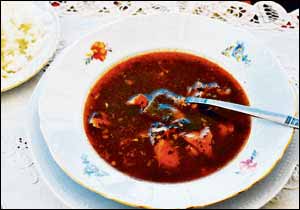| FOOD | |
| Add an Egyptian flavour to table | |
|
ONE of my favourite pastimes is encountering a new ethnic cuisine.
I love meeting the chefs, who show me the delicacies they learned to prepare when they were growing up, and I love tasting the new flavours and then watching how the dishes are put together. And as I learn the new techniques, I often hear stories from their childhoods and the cultures of their or their parents’ home country. This week, I met Ziona Ozatzkir-Masri, who prepared a traditional Egyptian meal consisting of dishes she learned from her mother, Fortuna. Fortuna grew up in Alexandria in a family with roots in Spain, and the family spoke Ladino among themselves. They had lived for a few generations in Jerusalem before moving to Egypt, which was a liberal and economically strong country at the time. She recalled hearing stories about neighbours from Europe and other Arab countries who spoke English, French and Italian. Ziona’s great-grandfather on her father’s side reached Egypt from the Austro-Hungarian Empire. He was an active Hagana operative and helped many young North African Jews reach then-Palestine. At one point he spent a year and a half in prison. After serving his time, his family was thrown out of Egypt, and Ziona’s family made its way to the Be’er Ya’acov ma’abara (transit camp) in Pardess Hanna, where they began acclimatising to life in Israel with all the other new immigrants. Egyptian cuisine is based on fresh seasonal vegetables, such as artichoke, leeks, okra, green beans, cauliflower, radish, garlic, onion, sweet potato and herbs, such as parsley and coriander. It also uses lots of legumes and fruits, such as pomegranates, figs, grapes, dates and mango. In Alexandria, everyone used the local oven to bake their own bread, and this was also where everyone would leave their hamin (cholent) pot for Shabbat lunch. Desserts incorporated a lot of silan and honey. Fortuna would use leftover bread in desserts or as bread crumbs and add leftover vegetables to omelettes. Nothing went to waste. On Rosh Hashana, they would make fried pumpkin with honey and cinnamon, and on Passover they’d make haroset from dried dates, nuts, raisins and cinnamon. When a baby’s first tooth began showing, they would prepare a big celebration featuring a dish made from wheat, milk, raisins, almonds, honey and cinnamon.
Maluchia (Egyptian Soup)
INGREDIENTS Soup:
Ravicha-Ta’aliya:
Additions for soup:
METHOD Add all of the soup ingredients to a large pot and cook for 40 minutes. Remove the onions and transfer to a blender. Add one cup of the soup to the maluchia and stir until mixed well. Pour maluchia mixture into soup and mix well. Continue cooking on low. At the same time, prepare the Ravicha-Ta’aliya. Heat the oil in a pan and then add the garlic, coriander, cumin, turmeric, salt and pepper. Sauté for 2 minutes. Take care not to let garlic burn. Pour into the soup and mix well. Cook for another 10 minutes over a low flame. Add the tomatoes or tomato paste, mix and then add lemon juice, salt and pepper. Bring to the boil and adjust seasonings. Serve with white rice.
Doah DOAH is an Egyptian spice mixture, and there are as many versions as there are Egyptian families. Some go heavy on the coriander seeds, while others like cumin or sesame seeds more. To make this mixture, each ingredient needs to be roasted separately, and then they’re all blended together in a food processor by using short pulses so it doesn’t get over-blended. Doah is served alongside a small saucer of olive oil, slices of onion, radish and tomatoes, and warm fresh pitot. INGREDIENTS
METHOD After roasting each herb separately, put all the ingredients in a food processor and pulse until mixed well. If you desire, add extra sesame seeds and salt, according to taste.
If you have a story or an issue you want us to cover, let us know - in complete confidence - by contacting newsdesk@jewishtelegraph.com, 0161-741 2631 or via Facebook / Twitter
|
